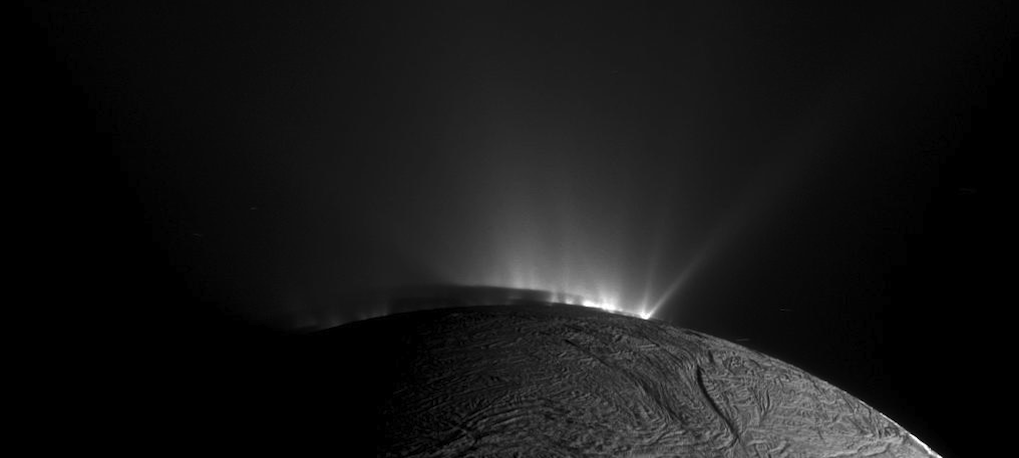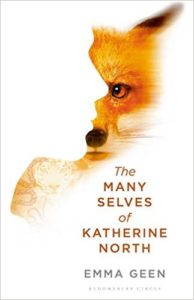
By Maureen Kincaid Speller
The Many Selves of Katherine North — Emma Geen (Bloomsbury)
 Of the six novels on my personal shortlist, Emma Geen’s The Many Selves of Katherine North is the one that disappointed me most when I came to read it. I originally picked it partly because there was a slight buzz about it online, and I am always curious about novels that provoke online chatter. I chose it too because I’d gained an impression, mostly erroneous as it turned out, that the main character would spend a considerable amount of her time as a fox (and indeed, the novel’s cover art rather implies that this will be the main thrust of the novel), and I’m oddly fascinated by the human preoccupation with vulpine transformations (also, I happen to like foxes a good deal). When I initially wrote about my choices, I invoked David Garnett’s odd little novel of transformation, Lady Into Fox, but having read Many Selves and reread Lady Into Fox, I can see now that I was wrong, except perhaps for one thing, which I’ll come to in due course. Instead, as I read on I found myself thinking more about T.H. White’s The Sword in the Stone. Again, I’ll come back to that shortly.
Of the six novels on my personal shortlist, Emma Geen’s The Many Selves of Katherine North is the one that disappointed me most when I came to read it. I originally picked it partly because there was a slight buzz about it online, and I am always curious about novels that provoke online chatter. I chose it too because I’d gained an impression, mostly erroneous as it turned out, that the main character would spend a considerable amount of her time as a fox (and indeed, the novel’s cover art rather implies that this will be the main thrust of the novel), and I’m oddly fascinated by the human preoccupation with vulpine transformations (also, I happen to like foxes a good deal). When I initially wrote about my choices, I invoked David Garnett’s odd little novel of transformation, Lady Into Fox, but having read Many Selves and reread Lady Into Fox, I can see now that I was wrong, except perhaps for one thing, which I’ll come to in due course. Instead, as I read on I found myself thinking more about T.H. White’s The Sword in the Stone. Again, I’ll come back to that shortly.
Katherine North – Kit – is a phenomenaut; that is, her consciousness is projected into the bodies of other animals. Kit calls it ‘research’, and as will become clear during the novel, her passion for animals of all kinds influences her hope that her work will enable humans to better understand the creatures they live alongside. Yet, in the novel’s opening sequence, we might wonder whether Kit wasn’t just doing the scutwork for other researchers; tracking lost animals, bringing back bits of information for others to use. She might regard herself as an important part of the team but to me there’s already a niggling sense of imbalance and inequality at play. She works for rather than with the researchers, and there’s little sense that her greatest insights into the lives of animals are given the attention they deserve.
Indeed, it’s not at all difficult to come to the conclusion that Kit is, on some profound level, being exploited by the company she works for, and has worked for since she was twelve. She is the oldest of the phenomenauts, the most experienced, and no one, least of all Kit herself, knows how long she can carry on doing this. They check her well-being at intervals, but there is little sense of how this is done, and there seems to be no ethical dimension in play, except insofar as we must assume ethical due diligence has been done in the past, and all is acceptable. For we are, though this is barely, and actually rather pleasingly, barely acknowledged, in an alternative present.
Kit herself fears for the time when she will no longer be a phenomenaut. She loves her work, but there is the sense that she exists only because of her work rather than independently of it. Because, for all this experience, there is something oddly unformed about Kit, something beyond the fact that she is still an adolescent, and it’s implied in her very name. She is proud of her name, a nickname bestowed on her by a family friend, but for all she reads it as a marker of her individuality and an acknowledgement of her independent existence, what is a kit but a juvenile animal, be it fox, rabbit, or cat? Kit was hired for the plasticity of her brain and I’m struck by how little sense we initially seem to have of her body. One is reminded of how medieval naturalists believed that mother bears literally licked their babies into shape; Kit’s body is not the body of a young adult woman, except insofar as it is the container to which her consciousness returns each time. Her fleeting descriptions of it suggest it has already been brutalised in the service of ShenCorp, what with sockets into which cables can be plugged, and the need to keep her hair very short. All of this suggests that Kit is as mouldable and unformed as a bear cub, and that ShenCorp has licked her into a shape suitable for its purposes. And, as it turns out, this is in part precisely what has happened. The body politics of this novel are complex, to say the least. And maybe this is a point where Many Selves does connect with Lady into Fox, if we choose to read the latter as an argument that freedom can be achieved only by eschewing human form if you are female.
Much of the novel is about the malleability of flesh. Kit’s consciousness is projected into animals that are printed in labs, rather than into actual wild creatures, and we see her witnessing the actual ‘printing’ process. We assume actual creatures have at some point been scanned but this raises interesting issues about whether Kit is projected into animals that are, on a higher level, a tabula rasa or whether she is some way partakes of their learned experience as well as their instincts. Certainly, we know that her consciousness exists within the creatures she inhabits but she seems to wear them rather than become them, at least to begin with. And this is part of the problem I have with this novel, in that there are no many selves of Katherine North; there is just the one self, popping in and out of animal bodies.
And here we reach the reason why I made the connection with The Sword in the Stone. Merlin transforms the Wart into a number of different animals in order to teach him a series of lessons about survival and the nature of power, but also about seeing the world from a different point of view. The most memorable episode in the film comes when Wart is transformed into a small fish and becomes a potential dinner for the pike living in the castle moat. Readers of the novel will perhaps recall the night that Wart spends as a hawk in the castle mews, in a harsh parody of an army mess, at the mercy of the mad Captain Cully. What Kit brings back from her experiences in other animal consciousnesses is less easily quantified. What is increasingly clear is that she is bringing back scraps of other behaviours as animal traits become enmeshed in her consciousness – most notably, there is an intense focus on food and eating, and her narrative is suffused with sensual metaphors that are not human-based – and it is evident that she has formed an unprofessionally strong bond with Tomoko, the adolescent fox. But in terms of empathy and self-awareness, there is little sense that Kit has acquired more than she set out with. Indeed, if Mrs Tebrick’s transformation into a fox is an escape from the tedium of a stultifying daily routine, then Kit’s eagerness to continue transforming into an animal, any animal, can be read as a flight from the responsibilities of humanhood. And perhaps there is nothing for her to bring back because she simply cannot make those connections.
There is a problem in Lady into Fox in that we can never know what is in the mind of Mrs Tebrick as fox because the narrative is told from her husband’s bewildered point of view, and the same is true with Many Selves: we can never truly find out how animals think because Kit is never anything less than human when she is inside those printed bodies. But the point is that she also goes into them as less than fully human. Kit’s mother is suffering from some sort of degenerative disease which has robbed her first of her mobility and then of every scrap of that which made her human. Kit has struggled to cope with this and has sought escape; becoming a phenomenaut is perhaps the ultimate escape. She cannot empathise with her mother, only turn away from her. She is emotionally fragile, another reason why ShenCorp ought not to have exploited her skills as a phenomenaut, and she too is being transformed as a result of her work (one cannot help thinking of sports stars who enjoy immense success at a very young age – what happens afterwards?).
When the company offers Kit a new role, perhaps more mindful than she is of the way that things are going, and she realises that they are effectively asking her to play herself, in actual copies of herself, she unsurprisingly baulks. But the question might be, what is it precisely she baulks at? Is it the ethical issues raised by the discovery that her printed body exists, without her having given permission? Or is it at having to be hyper-human, not to mention seeing herself as an adult, and a sexualised adult at that. This is heavily signalled by the incident where she is projected into a whale’s body and ends up mating with another whale.
Laid out like this, the novel might seem to be very rich in ideas, and it is; we have yet to deal with the mysterious presence of an old woman called Grandmother Wolf, and Kit’s awareness of other presences when she is in animal bodies, or indeed the company’s apparent desire to move into tourism, projecting the minds of rich patrons into animals, for a whole new experience.
But this is where it all begins to fall down horribly. It’s clear that this novel has been thoroughly researched – each encounter with a new animal mind meticulously delineates Kit’s experiences in dealing with that consciousness, but something is missing, and that’s the emotional response. Whether Kit has suppressed her own emotional responses as much as possible or simply doesn’t have any is unclear; but however well described each encounter is, the lack of emotional response renders it abstract, an artefact of fine writing rather than a felt experience. In the same way, although Kit has withdrawn from her mother emotionally, we should still feel the emotional weight of that withdrawal, but it’s not there. Even absence ought to leave traces, and yet those traces can’t be found.
Of course, the one thing that Merlin could not properly teach Wart about, not until it was already too late, was about emotional love and its consequences, because he himself had no real idea, not until he fell disastrously in love himself, a cue that Arthur must inevitably miss. And that is the difficulty here; there is no way for Kit to acquire that education she so desperately needs in order to survive in an adult world (I’m fairly sure that whale sex is not going to help here, nor even aborted bat sex).
Indeed, given the lack of interrogation of these emotional issues, I did wonder for a while whether The Many Selves of Katherine North was intended to be a young adult novel, focusing on Kit’s outer engagement with the adult world rather than with her inner landscape. I don’t think it is, in part because the other major problem with this novel is the plotting. Yes, things happen, things are found out, things are resolved or not resolved, but it’s the manner of their resolution, or not, that is so disappointing. One might argue that the ways in which discoveries are made and trail off might be true to real life, but fiction is not real life, and we have a reasonable right to expect resolutions and the tying off of loose ends. Indeed, if this were a young adult novel, I’d be looking for a definite move towards a restitution in which the characters can move forward into a new life, affirmed in a sense of achievement at having struck a blow against the forces of evil, or at any rather commerce, rather than the lacklustre ending in which Kit decides the time has come to be a grown-up with the man she now realises she loves because she is looking outward, finally, towards the world, and not inward. One is oddly reminded of Miranda, in The Tempest, commenting ‘oh brave new world that has such people in it’, on first making the acquaintance of the dubious pack of humans that a shipwreck has delivered to her door, without the ability to distinguish between the good and that which should prompt her to run for the hills. And never mind the fact that Kit has just cost her beloved his job, and with it pretty much his entire reason for being, a thing she ought to know a little about.
But that is all we have. If the executives of ShenCorp are to be taken down, we are not going to see it, any more than Grandmother Wolf’s identify is going to be fully unravelled, or Kit will make her peace with her mother. Ethical issues will remain only ever sketchily explored. The list goes on. And finally, we have to accept that whatever this novel is about – and in some ways it has a lot to recommend it in terms of its ambition for itself as a complex story of identity and treachery – it has sacrificed itself on the altar of exquisite writing. And, it turns out, exquisite writing, no matter how exquisite, really isn’t enough. A novel needs good bones as well as perfect skin, and the bones here provide insufficient scaffolding for the narrative they’re being asked to support. There is too little on which the reader can gnaw. In the same way, much as I admire the author’s willingness to engage with telling a story by having the various strands of plot perform a complicated pas de deux through time, this is not enough to excuse the lack of substance. This is, if you like, a projection of a novel rather than a novel itself. It is, like its protagonist, an unfinished thing that still needs licking into shape.
*
Maureen Kincaid Speller is a critic and reviewer. She is Senior Reviews Editor at Strange Horizons, and Assistant Editor of Foundation: the International Review of Science Fiction. She also reviews for Interzone and Vector. She is a former Arthur C. Clarke Award judge, and a former James Tiptree Jr. Award judge. She also blogs at Paper Knife.
>> Read Maureen’s introduction and shortlist.


